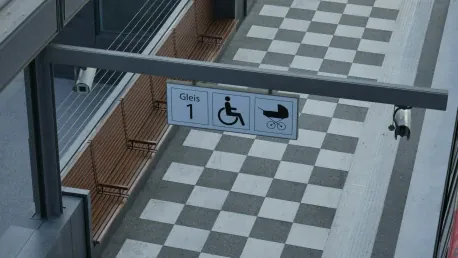Recent changes by Singapore’s Building and Construction Authority (BCA) aim to significantly advance building accessibility for seniors, wheelchair users, and nursing mothers. These updates, outlined in the latest Code on Accessibility in the Built Environment, focus on inclusivity and user-friendly designs in both new and existing structures. Starting in November, building plans must now accommodate these new accessibility standards to enhance community engagement and support. The new mandates include the provision of ramps, larger lifts, seating areas, wheelchair-accessible routes, and lactation rooms, addressing the diverse needs of the populace.
Accessibility Features
One of the cardinal points of the updated regulations is the requirement for all major building entrances, which connect with neighboring buildings, transport facilities, park connectors, and covered walkways, to be wheelchair-accessible. This ensures seamless mobility for those using wheelchairs and other mobility aids. Additionally, if shelters are provided, priority must now be given to accessible routes so wheelchair users are not stranded during heavy rains. These changes emphasize the need for safety and convenience, making public spaces more inviting and usable for all individuals.
Furthermore, ensuring accessibility isn’t confined to entrances alone. The legislation mandates various internal adjustments to facilitate ease of movement within buildings. Ramps are a crucial element in this regard, enabling smooth movement between different levels where lifts or escalators might typically be the norm. The inclusion of tactile features at the top and bottom of staircases is beneficial for visually impaired individuals, allowing them to navigate more securely. These tactile features have proven effective in preventing accidents, thereby fostering a sense of independence and safety.
Lifts Enhancements
Another significant upgrade pertains to lift enhancements. The new regulations require lift cars to be spacious enough to accommodate personal mobility aids. This change not only addresses the need for sufficient space but also ensures a comfortable experience for users. Control buttons and mirrors positioned to facilitate easy use by wheelchair users highlight a thoughtful design approach. The positioning caters specifically to the ergonomic needs of those with limited mobility, promoting greater ease of use and better user experience within lifts.
Additionally, the improved lift standards contribute to quicker and safer boarding and disembarking processes, which are essential during peak hours or emergencies. The requirement for larger lifts underscores the importance of inclusivity and efficiency in public infrastructure. These enhancements mirror a larger trend towards universal design principles, aiming to incorporate accessibility features that benefit a wider range of users. This progressive approach serves to bridge gaps between different user groups, ultimately fostering a more inclusive urban environment.
Senior-Friendly Amenities
Providing amenities tailored for seniors is a key focus of the updated regulations. The inclusion of more seating areas, particularly at drop-off points, caters to the need for frequent breaks among older adults. These seating areas encourage social interactions and provide rest opportunities, essential for promoting active living among the elderly. Additionally, integrating higher proportions of toilet cubicles with grab bars directly responds to mobility challenges faced by seniors, aiding their independence significantly.
Moreover, these senior-friendly additions resonate well with the broader goal of healthy and active aging. They enable seniors to maintain a more engaged lifestyle, reduce dependency, and enhance their overall well-being. Community spaces with adequate seating and accessible bathrooms promote greater participation in social activities, fostering a sense of belonging and engagement. The thoughtful inclusion of these amenities reflects a commitment to creating a supportive environment for the aging population, an increasingly relevant focus in urban planning.
Support for Nursing Mothers
Nursing mothers will find the new mandates particularly beneficial, with the requirement for lactation rooms in various establishments such as shopping malls, offices, business parks, and educational institutions. This provision marks a significant shift in supporting the needs of nursing mothers, who often struggle to find suitable spaces for lactation. The inclusion of these rooms offers privacy and comfort, encouraging mothers to carry out essential caregiving activities without inconvenience.
The lactation rooms must be equipped with necessary amenities to facilitate a conducive environment for nursing. This development underscores a broader societal recognition of maternal needs, integrating family-friendly features into public and work environments. The BCA updates echo an inclusive approach, ensuring that diverse user groups, including nursing mothers, receive adequate facilities to manage daily requirements effectively. This step forward highlights the importance of providing holistic support frameworks in communal spaces.
Tactile Features for Visually Impaired Individuals
Supporting visually impaired individuals through thoughtful design modifications is another pivotal area of the updated regulations. The requirement for tactile features at the top and bottom of staircases facilitates better navigation for those with visual impairments. These tactile indicators, comprising raised patterns detectable through touch, help individuals recognize changes in elevation, ensuring safer movement within buildings.
Integrating tactile features is not merely about functional necessity; it reflects a deeper understanding of the nuances involved in accessible design. By incorporating these elements, spaces become more intuitive and navigable, reducing instances of accidents and promoting a safer environment. This approach aligns with universal design principles, aiming to create environments that cater comprehensively to various groups. The focus on tactile features exemplifies a commitment to inclusiveness and safety in public infrastructure.
Future Considerations and Support
The introduction of the updated accessibility regulations is supported by the Accessibility Fund, which offers substantial subsidies for construction costs related to these features. This financial support is crucial for ensuring that building owners and developers can integrate necessary updates without excessive financial burden. The fund demonstrates a proactive approach by BCA to foster compliance and encourage widespread adoption of the new standards.
Architects and building professionals now face the task of managing available spaces creatively to incorporate these updates without necessitating complete redesigns. This flexibility is essential for maintaining architectural integrity while enhancing accessibility. Furthermore, the establishment of the review committee, comprising diverse stakeholders committed to enhanced accessibility, ensures a collaborative approach to finalizing these regulations. Since 1990, BCA’s efforts to revise accessibility codes emphasize continued progress in creating inclusive and supportive built environments.
Summary of Key Takeaways
Recent updates by Singapore’s Building and Construction Authority (BCA) are set to greatly improve building accessibility for seniors, wheelchair users, and nursing mothers. These changes, included in the latest Code on Accessibility in the Built Environment, emphasize inclusivity and practical designs for both new and existing buildings. Beginning in November, new building plans must adhere to these updated accessibility standards to promote better community engagement and support. The new rules mandate the installation of ramps, larger elevators, designated seating areas, wheelchair-friendly routes, and lactation rooms. These enhancements aim to meet the diverse needs of the population, ensuring everyone, regardless of their physical capability, can navigate public spaces with ease. By mandating these features, the BCA is taking significant steps towards creating a more accessible and inclusive environment for all citizens. This move not only aims to improve the quality of life for many but also supports a more integrated society.









